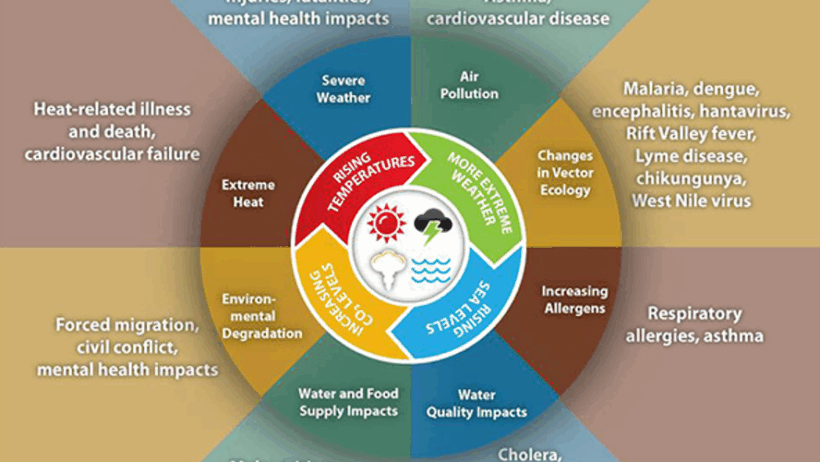Global warming, akin to an insatiable beast, exerts its voracious influence on the intricate tapestry of life, unraveling the very fabric of human health. As temperatures rise, the ramifications ripple through ecosystems and communities, affecting not just the planet but the organism that calls it home—human beings. The nexus between climatic shifts and health is profound, dictating everything from the emergence of new diseases to exacerbation of chronic conditions.
To understand how global warming affects the human body, one must first recognize that our health is intricately linked to the environment. The ambient climate is more than a backdrop; it is a living canvas that shapes our biological processes. As the Earth’s temperature escalates, so does the likelihood of severe health risks, creating a labyrinth of challenges for public health.
One of the most immediate manifestations of climate change is the increase in heat-related illnesses. During the sweltering summer months, temperatures soar beyond the thermal comfort zone, leading to heat exhaustion and heatstroke. These conditions arise when the body’s thermoregulatory systems are overwhelmed, unable to dissipate heat efficiently. Vulnerable populations, including the elderly and those with preexisting health conditions, experience the brunt of these effects. Prolonged exposure to extreme heat can catalyze cardiovascular events, exacerbate respiratory issues, and contribute to a premature demise.
Moreover, global warming fosters an environment ripe for the proliferation of vectors such as mosquitoes and ticks. These organisms flourish in warmer temperatures, extending their range and increasing their populations. Consequently, diseases such as malaria, dengue fever, and Lyme disease are re-emerging in places previously considered safe. Each infected individual becomes a testament to the complex interplay between climate and public health, a stark reminder that the warming world can ignite a resurgence of these perilous pathogens.
In addition to infectious diseases, air quality is undeniably impacted by rising temperatures. The disheartening dance of particulate matter and pollutants becomes more pronounced as climate change alters atmospheric conditions. Ozone levels, in particular, see an uptick on hot days, contributing to a cocktail of respiratory ailments. Asthma, chronic obstructive pulmonary disease, and other pulmonary disorders grow more prevalent. The lungs, delicately designed for optimal gas exchange, are besieged by the increasing burden of air pollution, which acts like a suffocating shroud.
Water resources, as the lifeblood of humanity, are jeopardized in a warming climate. The disruption of the hydrological cycle leads to both floods and droughts, creating a paradox that threatens access to clean drinking water. Contaminated water supplies can lead to outbreaks of gastrointestinal diseases, while drought can exacerbate malnutrition by hampering agricultural productivity. Thus, the ripple effect of climate change on one’s access to clean water can cascade into myriad health risks, highlighting the interconnectivity of environmental and human health.
Yet, the health implications of global warming extend beyond immediate physical ailments. Mental health emerges as a silent casualty in this atmospheric upheaval. The anxiety and despair fueled by the relentless progression of climate change can overwhelm individuals and communities alike. Extreme weather events—hurricanes, wildfires, and floods—leave psychological scars that linger long after the physical destruction is rectified. The mental health crisis birthed from climate-related trauma is an urgent issue, necessitating a cacophony of voices advocating for comprehensive mental health support frameworks.
In the context of global warming, a phenomenon known as “climate migration” has gained prominence. As areas become unlivable due to sea-level rise, extreme weather, or lack of resources, populations are forced to relocate. The stressors associated with such upheaval—loss of home, community, and stability—pose significant health risks. The fabric of society is tested as displaced individuals grapple with disease prevalence, limited access to healthcare, and the psychological toll of their displacement.
To combat these multifaceted threats to human health, a concerted effort must be enacted on global and local scales. Mitigation and adaptation strategies are paramount. Transitioning to renewable energy sources can curtail emissions, thereby tempering climate change and its associated health risks. Urban planning must incorporate green spaces to alleviate heat accumulation in cities, fostering an environment conducive to wellbeing. Public health infrastructures must adapt to ensure accessibility and equity, particularly for vulnerable populations.
In closing, as the allegorical storm of climate change swirls around us, it becomes imperative to acknowledge the inextricable ties binding our health to the health of the planet. Humanity stands at a critical juncture; understanding and addressing the health risks posed by global warming is not merely an option but an imperative. The intersection of environmental stewardship and public health is an evolving narrative that demands our immediate attention and action, lest we find ourselves ensnared by a future wrought with unprecedented health crises. Together, the journey toward resilience and sustainability continues, reminding us that our societal commitment to the Earth will ultimately define the health of future generations.







